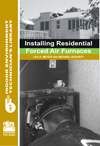An HVAC contractor’s focus is often on sealing the duct system. But would you say sealing the building envelop is just as important? Why?
The top causes of air leakage and infiltration into the home are ductwork and the building envelope. Energy savings derived from air sealing the building envelope have been challenging to achieve when applied manually. At the same time, standards for envelope tightness are escalating.
Aeroseal developed AeroBarrier based on feedback from the builder community so they can respond to these challenges. The technology takes builders from hoping to knowing they can meet any IECC, Energy Star, or passive house requirement more consistently and more cost-effectively than traditional air sealing methods.
What technology is involved in AeroBarrier’s computer-controlled system that allows it to measure how sealed an envelope is?

AeroBarrier is injecting aerosolized sealant into a pressurized space using a blower door. Our
proprietary software and sensors do the rest, including real-time pressure measurements. Throughout the application process, the computer displays the ACH improvement, allowing the contractor full control over the desired level of envelope tightness and leakage reduction.
About how long does it take AeroBarrier to seal the average residential envelope? Commercial envelope?

Several factors, including the building size, come into play. However, the entire AeroBarrier process, from setup to completion, takes approximately four hours for a typical, single-family home. When targeting reduced envelope leakage levels of Passive House or ZERH, additional time may be required.
In terms of labor savings, what’s the difference between manual and AeroBarrier’s computerized sealing systems?

AeroBarrier takes considerably less time than manual air sealing and guarantees results. Contractors go from hoping to knowing they’ll pass the blower door test. AeroBarrier users are already seeing labor savings using this technology. Over time, as the technology becomes even simpler to operate, these savings will continue to increase.
Do you have comparison statistics for energy usage before and after AeroBarrier?

For IBS 2020, AeroBarrier was applied to The New American Home Remodel. We achieved a 90 percent reduction in envelope leakage in just a few hours. We took the home from 10,290 CFM of leakage or 8.86 ACH down to 1645.4 CFM of leakage or 1.42 ACH.
For New Tradition Builders, we took a home’s ACH from 2.6 down to .6 in less than 90 minutes. The reduced energy demand resulted in the home needing fewer solar panels to achieve its zero energy goals.
And In a multi-family building, we took 11214.1 CFM or 11.3 ACH down to 489.7 CFM or 4.6 ACH – a 59.7 percent reduction in building envelope leakage.
Is sealing the building envelope best before or after duct sealing?
AeroBarrier air sealing can be used in new construction, once the home has been roughed in. It can also be used in unoccupied homes, prior to taking residence. Aeroseal duct sealing can be applied in any scenario, new construction as well as occupied homes. It all depends on the home and the homeowners goals as to whether you use both or a combination of the two.
AeroBarrier in five steps.
1. Setup
Set up AeroBarrier equipment — including compressor, generator, blower door, emitters, hoses and the AeroBarrier machine — at the job site.
2. Prep
Prep the space, taping or covering any areas that won’t be sealed. Emitters are then set up throughout the area to be sealed.
3. Pressurize
Pressurize the space with the use of a blower door. A computer does the rest, including the control of temperature, pressure, humidity, and distribution of sealant during the process.
4. Seal
Seal and see the results in real-time throughout the application process. The computer monitor displays the ACH improvement, allowing you full control over your desired level of envelope tightness and the leakage reduction.
5. Certify
Run a final blower door test to verify the sealing results. At the end of the process, receive an AeroBarrier Certificate, with a pre and post leakage report.
This story originally appeared in the January 2020 issue of SNIPS magazine.





.jpg?height=200&t=1675271240&width=200)


